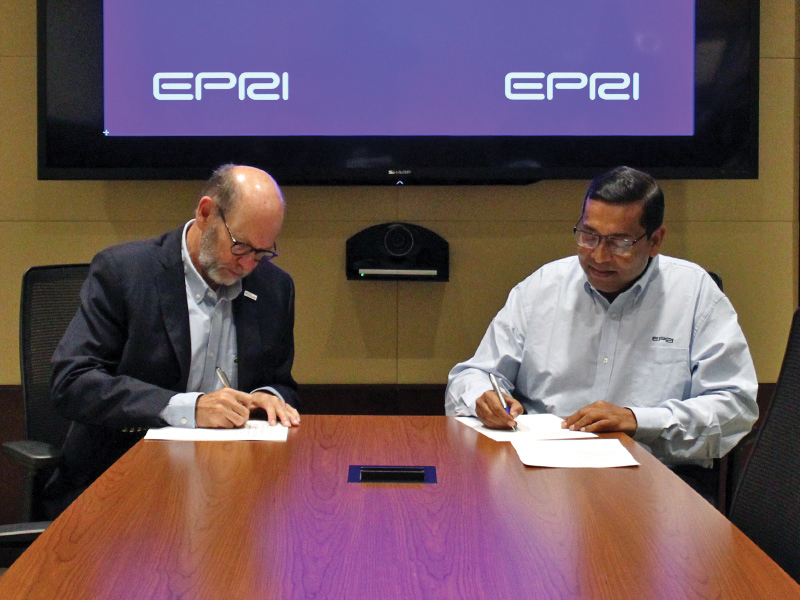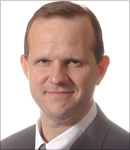Recently, the North American Electric Reliability Corporation (NERC) and the Electric Power Research Institute (EPRI) announced a collaboration to “enable improved resiliency and reliability of the North American electric grid.” For the Q3 Grid Transformation Forum, we asked Andrew Philips, vice president of EPRI's Transmission and Distribution Infrastructure sector and Mark Lauby, senior vice president and chief engineer with NERC, to talk about the agreement and how they see the collaboration unfolding.
EET&D – What do you consider to be the most significant impact this agreement will have on the electric power sector? How will the electric power sector benefit?
Andrew Phillips, EPRI – This agreement is about bringing together both our organizations – which have unique roles and relationships within the power industry – to better serve the electric power sector and, ultimately, society. Our collective knowledge is stronger than our individual work. This partnership will allow us to more effectively and efficiently respond to the current and future challenges facing the electric power industry. Bringing our organizations closer together through regular meetings and collaboration on key issues and research activities will accelerate innovation, solve reliability challenges and help build a more resilient bulk power system (BPS).
Mark Lauby, NERC – Our two organizations each have access to an exceptional set of employees who are subject matter experts and industry participants. This combined level of experience and expertise is significant and will be highly effective in addressing the current and emerging resiliency, security and reliability issues facing the BPS. In addition, through NERC’s committee structure, many risks and trends are identified early. Our agreement enables NERC and EPRI to jointly develop tools and initiatives that effectively mitigate existing and emerging risks to BPS reliability.
EET&D – What are the strengths each organization brings to this collaboration?
AP – EPRI draws on the strength and technical expertise of our scientists and engineers, as well as experts from academia and industry, to produce research and science-based information to enhance the generation, delivery, and use of electricity.
EPRI’s labs were designed and developed over decades with unique capabilities going beyond standard testing to address some of the most relevant and difficult issues facing the industry. These test capabilities enable the confirmation and development of models and theories used to address some of the most complex problems in improving reliability and resiliency of the BPS.
EPRI’s outdoor, high-voltage laboratory in Lenox, MA can simulate up to 1,200-kV full-scale AC transmission line or 1,500-kV DC., as well as lightning impulses up to 5 MV. Our lab in Charlotte, NC focuses on developing and evaluating new underground cable concepts, as well as asset monitoring technologies such as sensors for transformers or conductors. In Charlotte and Knoxville, EPRI uses some of the largest privately-owned EMP generators to simulate the electromagnetic effects of a high-altitude nuclear blast on electronic equipment.
ML – NERC’s greatest commodities are its people and its structure. Similar to EPRI, NERC employees are largely drawn from within the industry (e.g. government, research and engineering) and bring, operational, technical and policymaking expertise to the collaboration. In addition, through its governance structure, which supports several stakeholder-populated technical committees, NERC also brings a wide-ranging perspective from the industry and stakeholders in North America. NERC’s technical committees, such as the Reliability Issues Steering and Reliability Security Technical Committees, work to identify current and emerging threats to reliability thereby highlighting issues that may be investigated through this collaboration. NERC also has an 11-member Board, who act impartially on behalf of a broad and diverse range of stakeholders.
EET&D – Why now?
ML – A highly reliable, resilient, and secure BPS is at the core of NERC’s mission,and we are focused on proactively addressing the risks to the reliable operations of the BPS. The transforming grid creates challenges and opportunities to support this mission. For example, the ability to deliver energy is becoming increasingly hampered during certain common widespread, long-duration conditions such as extreme hot or cold temperatures. The electricity sector is undergoing significant changes that are unprecedented in both transformational nature and rapid pace. Initiatives are underway to address these risks, the management of reliability, resilience and security requiring increased focus right now and our collaboration with EPRI is part of that effort.
AP – Two of the main pillars of a decarbonized future are the generation of electricity from renewable resources and the conversion of fossil-fueled systems to electricity. This makes for a future where society is more dependent on electricity, which is generated from a different mix of resources in different locations. As a result, enhancing the reliability and resiliency of the BPS is more important than ever. There will be many new unknowns and future challenges to navigate. The whole industry has a role to play in rising to the challenge, with NERC and EPRI playing vital roles.
Through the clean energy transition, electrification will continue to expand in countries, industries and businesses across the globe. Our partnership will help ensure power companies and stakeholders are prepared and equipped to deliver electricity efficiently, reliably and resiliently.

Jim Robb, President and CEO, NERC and Arshad Mansoor, President and CEO, EPRI sign MOU.
EET&D – What are some of the greatest challenges the industry must overcome for your effort to succeed?
AP – Ensuring resilience and reliability as electrification
grows is one – if not the most important issue at hand. Success involves accounting for present and future challenges, including extreme weather events. We also must factor in changes in the resource mix, evolving technology and emerging threats such as cybersecurity, physical security, geomagnetic storms and electromagnetic pulse (EMP).
At EPRI, we know that science holds the solution to these challenges. And advancing science is what we do best. Our partnership with NERC will help us identify the most urgent and relevant topics to work on, as well as increase the application of our findings to more stakeholders. We believe this will amplify the value of innovation and accelerate building a more reliable and resilient industry.
ML – The industry is facing many challenges such as grid transformation; cyber and physical security threats; increased vulnerability due to extreme weather events, especially those related to extreme temperatures; and critical infrastructure interdependencies such as the ability to deliver natural gas to generating units. This transformation must be understood and planned for to preserve and improve reliability. At NERC, we are observing three major trends that are changing the reliability ecosystem.
First, the BPS is decarbonizing rapidly as policies, economics and customer preferences drive the retirement of traditional baseload generation. This evolution is altering the operational characteristics of the grid. Second, the grid is becoming more distributed. The improved economics of solar is a key driver of this dynamic. Grid operators need more control and visibility into many of these resources. And third, the system is becoming increasingly digitized through smart meters and advanced control systems. These investments greatly enhance operational awareness and efficiency but increase our exposure to cybersecurity risk. Managing this pace of change is the central challenge for reliability.
EET&D – To what extent will NERC and EPRI’s next steps require buy-in from utility providers?
ML – NERC and EPRI have collaborated closely and successfully for many years. It is a highly complementary and beneficial relationship that combines NERC’s ability to identify issues that may compromise the reliability and resilience of the BPS and EPRI’s scientific and technological expertise. The industry has already benefited from our previous collaboration and we believe our strong track record continues to engender support from our stakeholders.
AP – EPRI and NERC have been working together for decades, with EPRI research results being used as the technical basis for numerous NERC standards, such as the minimum distance from a tree to a transmission line, how to address solar storms from the sun or how to design a substation to make it resilient to an electromagnetic pulse from a nuclear weapon exploded in outer space. We hope the reaffirmation of our partnership is seen as a win for the power sector and the public. By working together with a shared vision to serve the electric power sector, we believe all stakeholders will quickly see the value and benefit of our combined efforts.
EET&D – How will the collaboration between you ensure improved grid resiliency or fewer grid failures like what we saw in Texas this past winter?
AP – As a result of Texas and other recent events, EPRI has launched research into how to ensure resource adequacy during future extreme weather events while accounting for a changing resource mix. NERC is being engaged in this effort and we expect the results to inform the future management of the grid.
Improving grid technology while ensuring reliability and resiliency is a priority for both of our organizations. As such, we expect our partnership may identify new or expanded research opportunities to help overcome current and future challenges related to grid operations.
ML – Through our assessments that identify and quantify emerging reliability issues, NERC can provide risk-informed recommendations and support a learning environment for the industry to pursue improved reliability performance. These recommendations, along with the associated technical analysis, provide the basis for actionable enhancements to resource and transmission planning methods, planning and operating guidelines and NERC Reliability Standards. Our partnership with EPRI brings the appropriate scientific and technological expertise to the development of potential solutions.
EET&D – How will you measure the effectiveness of your collaboration?
AP – For EPRI, effectiveness will be measured by working on the key issues and risks that
NERC and its stakeholders have identified as being important for BPS. Success means that EPRI research and results continue serving as the technical basis used in the NERC process when developing or revising standards.
We expect this to be a mutually beneficial collaboration where EPRI and NERC provide input to each other. This ensures we’re jointly identifying the most important BPS issues and providing the most relevant and helpful research to support these challenges.
ML – At NERC, effectiveness will be measured through the feedback obtained from our stakeholders, the level to which reliability and reliance have been enhanced, and the issues that may impact the BPS can be mitigated.
 Andrew Phillips is vice president of transmission and distribution infrastructure. He provides executive oversight and direction for research, development and demonstration programs addressing asset management, operations, planning and integration. During his career at EPRI, Phillips has led the industry in developing advanced approaches and technologies to manage a range of T&D assets. Since joining EPRI in 1998, he has led various research programs and initiatives covering transmission and distribution infrastructure and systems.
Andrew Phillips is vice president of transmission and distribution infrastructure. He provides executive oversight and direction for research, development and demonstration programs addressing asset management, operations, planning and integration. During his career at EPRI, Phillips has led the industry in developing advanced approaches and technologies to manage a range of T&D assets. Since joining EPRI in 1998, he has led various research programs and initiatives covering transmission and distribution infrastructure and systems.
Phillips earned a Bachelor of Science, Master of Science, and Doctor of Philosophy in electrical and electronics engineering from University of the Witwatersrand, in Johannesburg, South Africa.
He holds 16 U.S. patents and is the author of more than 60 journal and conference publications. He is a member of IEEE and CIGRE and is a registered professional engineer.
 Mark G. Lauby is senior vice president and chief engineer at NERC in January 2007 and has held a number of positions, including vice president and director of Standards and vice president and director of Reliability Assessments and Performance Analysis.
Mark G. Lauby is senior vice president and chief engineer at NERC in January 2007 and has held a number of positions, including vice president and director of Standards and vice president and director of Reliability Assessments and Performance Analysis.
In 2012, Lauby was elected to the North American Energy Standards Board and was appointed to the Department of Energy’s Electric Advisory Committee by the Secretary of Energy from 2013–2017. He has been recognized for his achievements by many technical associations, including the 1992 IEEE Walter Fee Young Engineer of the Year Award. He was named a Fellow by IEEE in November 2011 for “leadership in the development and application of techniques for bulk power system reliability,” and in 2014, he was awarded the IEEE Power and Energy Society’s Roy Billinton Power System Reliability Award. In 2020, the National Academy of Engineering (NAE) elected Lauby as a member, citing his development and application of techniques for electric grid reliability analysis.
Prior to joining NERC, Lauby worked for the Electric Power Research Institute (EPRI) for 20 years, holding a number of senior positions, including: director, Power Delivery and Markets; managing director, Asia, EPRI International; and manager, Power System Engineering in the Power System Planning and Operations Program. Lauby attended the London Business School Accelerated Development Program as well as the Executive Leadership Program at Harvard Business School






